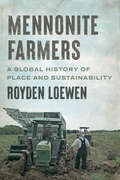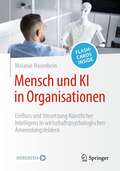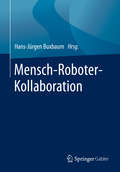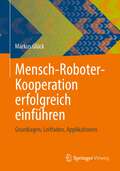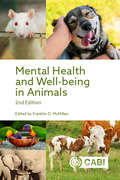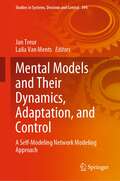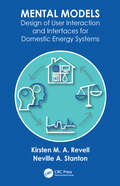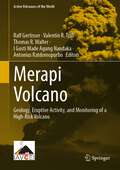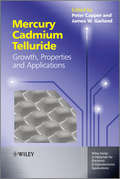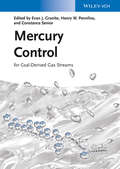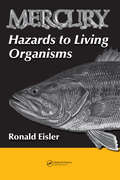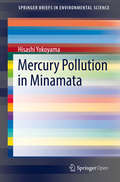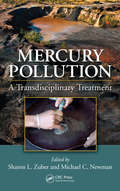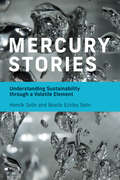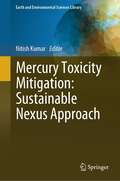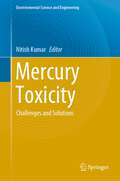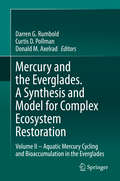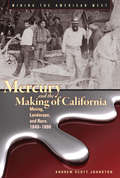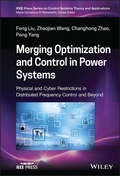- Table View
- List View
Mendeleyev's Dream: The Quest For The Elements
by Paul StrathernThe wondrous and illuminating story of humankind's quest to discover the fundamentals of chemistry, culminating in Mendeleyev's dream of the Periodic Table. In 1869 Russian scientist Dmitri Mendeleyev was puzzling over a way to bring order to the fledgling science of chemistry. Wearied by the effort, he fell asleep at his desk. What he dreamt would fundamentally change the way we see the world. Framing this history is the life story of the nineteenth-century Russian scientist Dmitri Mendeleyev, who fell asleep at his desk and awoke after conceiving the periodic table in a dream-the template upon which modern chemistry is founded and the formulation of which marked chemistry's coming of age as a science. From ancient philosophy through medieval alchemy to the splitting of the atom, this is the true story of the birth of chemistry and the role of one man's dream. In this elegant, erudite, and entertaining book, Paul Strathern unravels the quixotic history of chemistry through the quest for the elements.
Mennonite Farmers: A Global History of Place and Sustainability (Young Center Books in Anabaptist and Pietist Studies)
by Royden LoewenA comparative global history of Mennonites from the ground up.Mennonite farmers can be found in dozens of countries spanning five continents. In this comparative world-scale environmental history, Royden Loewen draws on a multi-year study of seven geographically distinctive Anabaptist communities around the world, focusing on Mennonite farmers in Bolivia, Canada, Indonesia, the Netherlands, Russia, the United States, and Zimbabwe. These farmers, who include Amish, Brethren in Christ, and Siberian Baptists, till the land in starkly distinctive climates. They absorb very disparate societal lessons while being shaped by particular faith outlooks, historical memory, and the natural environment. The book reveals the ways in which modern-day Mennonite farmers have adjusted to diverse temperatures, precipitation, soil types, and relative degrees of climate change. These farmers have faced broad global forces of modernization during the twentieth and early twenty-first centuries, from commodity markets and intrusive governments to technologies marked increasingly by the mechanical, chemical, and genetic. Based on more than 150 interviews and close textual analysis of memoirs, newspapers, and sermons, the narrative follows, among others, Zandile Nyandeni of Matopo as she hoes the spring-fed soils of Matabeleland's semi-arid savannah; Vladimir Friesen of Apollonovka, Siberia, who no longer heeds the dictates of industrial time of the Soviet-era state farm; and Abram Enns of Riva Palacio, Bolivia, who tells how he, a horse-and-buggy traditionalist, hired bulldozers to clear-cut a farm in the eastern lowland forests to grow soybeans, initially leading to dust bowl conditions. As Mennonites, Loewen writes, these farmers were raised with knowledge of the historic Anabaptist teachings on community, simplicity, and peace that stood alongside ideas on place and sustainability. Nonetheless, conditioned by gender, class, ethnicity, race, and local values, they put their agricultural ideas into practice in remarkably diverse ways. Mennonite Farmers is a pioneering work that brings faith into conversation with the land in distinctive ways.
Mensch und KI in Organisationen: Einfluss und Umsetzung Künstlicher Intelligenz in wirtschaftspsychologischen Anwendungsfeldern
by Melanie HasenbeinDieses Buch "Mensch und KI in Organisationen" zeigt Ihnen auf, welchen Einfluss die Künstliche Intelligenz und Robotik auf den Menschen in der aktuellen und zukünftigen Arbeits- und Organisationswelt hat. Das Werk nimmt Sie mit auf die Reise der Künstlichen Intelligenz in einzelnen psychologischen und wirtschaftspsychologischen Anwendungsfeldern.Auf der Basis von theoretischem Hintergrundwissen und aktuellen Studien sowie praktischen Umsetzungsmöglichkeiten erfahren Sie:wie Künstliche Intelligenz die Arbeits- und Organisationswelt verändert,was eine Mensch-KI-Interaktion und Mensch-Roboter-Interaktion kennzeichnet,wo KI und Roboter im Human-Resources-Bereich eingesetzt werden,welche zukünftigen Lernszenarien mit KI und Robotern möglich sind,wie eine hybride Führung und Teamarbeit zwischen Mensch, KI und Robotern aussehen kann und welche ethischen Grundsätze beim Einsatz von KI und Robotern zu berücksichtigen sind. Das Buch ist angereichert mit digitalen Fragen und Antworten, die Sie über die Flashcard App zum Selbsttest nutzen können. Die ZielgruppenProfessionals im Organisations- und Personalbereich, Berater, Trainer und CoachesStudierende der Wirtschaftspsychologie sowie der Angewandten und Digitalen Psychologie
Mensch-Roboter-Kollaboration
by Hans-Jürgen BuxbaumIm Kontext der Industrie 4.0 sind ein wachsender Wettbewerbsdruck, immer größere Anforderungen an Flexibilität und Qualität und immer höhere Ansprüche der Stakeholder wahrnehmbar. In der bekannten Situation des demographischen Wandels entstehen zunehmend neue Assistenzsysteme, insbesondere in der Mensch-Roboter-Kollaboration (MRK). Diese Systeme arbeiten nicht mehr isoliert hinter Zäunen, sondern Hand in Hand mit den Menschen. Sie sollen den Menschen bei monotonen oder kraftraubenden Arbeiten unterstützen oder entlasten. Durch die direkte Zusammenarbeit von Mensch und Maschine rücken Arbeitssicherheit und Ergonomie zunehmend in den Fokus. Klärungsbedarf gibt es bei der Gestaltung von MRK-Arbeitsplätzen und bei der Akzeptanz dieser Arbeitsplätze. Auch neue Aufgabenfelder sind im Gespräch, die sich z.B. in Pflege und Medizin erschließen lassen. Arbeitspsychologie und Human Factors bekommen in der roboterbasierten Automatisierung eine neue, wichtige Bedeutung. Zudem stellt sich die ethische Frage, ob diese neuen Roboter auf längere Sicht den Menschen entlasten oder ersetzen.Hintergrund dieser Veröffentlichung ist der Ladenburger Diskurs der Daimler und Benz Stiftung zum Thema MRK im März 2019. Dieser ist hervorragend besetzt mit einer deutlich interdisziplinären Ausrichtung, die in diesem Thema bislang einmalig ist. Die Teilnehmer sind Autoren dieses Buchs.
Mensch-Roboter-Kooperation erfolgreich einführen: Grundlagen, Leitfaden, Applikationen
by Markus GlückCobots - eine neue Generation an Leichtbaurobotern - unterstützen die Menschen bei der Erfüllung ihrer Produktionsaufgaben; auch im Mittelstand. Doch wie gestaltet man konkret das sichere Miteinander von Menschen und Robotern? Welche Sicherheitskonzepte und Normen gibt es? Wie begegnet man Ängsten? Wen muss man wie „mitnehmen“ auf die Reise in die neue Mensch-Roboter-Ära und was muss man dabei beherzigen? Dieses Buch vermittelt auf anschauliche und pragmatische Weise alles Wissenswerte und Notwendige, um die Mensch-Roboter-Kooperation (MRK) und Cobots rechtssicher im betrieblichen Alltag einzuführen. Es ist ein durchgängiger Leitfaden mit Orientierungshilfen.
Menschen und ihre Materialien: Von der Steinzeit bis heute (Erlebnis Wissenschaft)
by Hans R. KricheldorfWas verandert die Welt? Wer hat denn nun die Welt am starksten verandert: die Politiker, die Ideen in die Tat umsetzten, oder die Philosophen, von denen sie stammten? Oder vielleicht sogar jemand ganz anderes? Etwa der Erfinder des Papiers, ohne das weder Buchdruck noch Reformation denkbar waren? Oder auch diejenigen, die Eisen und Bronze hervorbrachten und damit ganze Epochen begrundeten. Dieses Buch belegt eindrucksvoll: Unsere Geschichte ist immer auch die der Materialien, die wir verwenden. Geschichte neu geordnet Systematisch geht der Autor der Frage nach, wie die Entwicklung von Kulturen und die Moglichkeiten der Materialherstellung zusammenhangen. Er durchstreift die Jahrtausende und setzt dabei bestimmte Zeiten und Materialgruppen zueinander in Beziehung. Dabei beleuchtet er nicht zuletzt spannende Details von Herstellung und Verarbeitung. Alternative Realitaten Und auch Gedankenspielen gibt das Buch Raum, denn die Frage >Was ware wenn?materiellen
Mental Health and Social Issues Following a Nuclear Accident
by Jun Shigemura Rethy Kieth ChhemThis book focuses on mental health issues arising in the wake of the Fukushima nuclear disaster. Three years after the 11 March 2011 Great East Japan Earthquake, tsunamis, and Fukushima Daiichi nuclear accident, roughly 130,000 individuals continue to face enormous burdens as a result of mandatory evacuation. Many evacuees still live in temporary housing, and returning home remains a distant dream as they wait for the decontamination of the danger zone to be completed. However, the plant recovery process is still evolving, and the complete cleanup will take decades. Beyond all of these hardships, many evacuees are also mourning the loss of their loved ones. The compound disaster with its many uncertainties poses and will continue to pose serious emotional and social challenges. People affected by the nuclear disaster have been facing serious psychological challenges from ongoing fear of radiation exposure. Furthermore, there is continuing debate between various stakeholders on the options for disaster responses. This situation in turn produces adverse public responses, such as discrimination and stigmatization of the evacuees and scapegoating of the authorities and nuclear plant workers. Mental Health and Social Issues Following a Nuclear Accident addresses these issues and their impacts, pursuing both evidence-based and narrative-based approaches. It also contrasts the Fukushima findings with those of other nuclear disasters, namely, Three Mile Island and Cher nobyl.
Mental Health and Well-being in Animals
by Karen L. Overall Temple Grandin Alexander Weiss Debra F. Horwitz Ngaio J Ngaio J Gary Landsberg Ian J.H. Duncan Professor Michael Mendl Professor Daniel Mills Dr Gina Alvino Melissa Bain C. A. Buffington Larry Carbone Kathy Carlstead Sharon Crowell-Davis Dr Victoria Cussen Carine Elkhoraibi Daniel Q. Estep Sophie S. Hall Suzanne Hetts Lori Marino David J. Mellor Elizabeth S. Paul Pamela J. Reid Claire Ricci-Bonot Lauren M. Robinson Amy Robinson-Junker Lynne M. Seibert David Shepherdson Daniel M. Weary Jacqueline Wilhelmy James W. YeatesThe second edition is fully revised, expanded, and comprehensively updated with the most current knowledge about the full array of mental health issues seen in animals. Written by key opinion leaders, internationally-recognized experts and specialists, it is comprehensive covering basic principles to mental wellness, emotional distress, suffering and mental illness, through to measurement and treatment. With even more practical information and clinical pearls, this book remains invaluable to veterinary professionals, animal welfare researchers and advocates, and other animal caregivers.
Mental Models and Their Dynamics, Adaptation, and Control: A Self-Modeling Network Modeling Approach (Studies in Systems, Decision and Control #394)
by Jan Treur Laila Van MentsThis book introduces a generic approach to model the use and adaptation of mental models, including the control over this. In their mental processes, humans often make use of internal mental models as a kind of blueprints for processes that can take place in the world or in other persons. By internal mental simulation of such a mental model in their brain, they can predict and be prepared for what can happen in the future. Usually, mental models are adaptive: they can be learned, refined, revised, or forgotten, for example. Although there is a huge literature on mental models in various disciplines, a systematic account of how to model them computationally in a transparent manner is lacking. This approach allows for computational modeling of humans using mental models without a need for any algorithmic or programming skills, allowing for focus on the process of conceptualizing, modeling, and simulating complex, real-world mental processes and behaviors. The book is suitable for and is used as course material for multidisciplinary Master and Ph.D. students.
Mental Models: Design of User Interaction and Interfaces for Domestic Energy Systems
by Neville A. Stanton Kirsten M. RevellThere is a resurgence of interest in mental models due to advances in our understanding of how they can be used to help design and due to the development of practical methods to elicit them. This book brings both areas together with a focus on reducing domestic energy consumption. The book focuses on how mental models can be applied in design to bring out behaviour change resulting in increased achievement of home heating goals (reduced waste and improved comfort). This book also offers a method to extract and apply mental models to interface design. The approach enables mental models to be applied across domains when behaviour change was sought, and is validated as a useful design method.
Mentoring and Sponsoring: Keys to Success
by Maria Angela Capello Eve SpruntThis book is a compilation of very personal approaches to mentoring and sponsoring, breaking the stereotypes of seniority, age or experience. The authors have provided a platform to understand that mentoring and especially sponsoring are in fact a win-win relation, in which both sides, mentors and mentees; and sponsors and sponsored individuals learn from each other, enhancing their career paths. How they managed to create a growth space for themselves and their teams through mentoring and sponsoring, is a story of professional leadership. They shared a privileged outlook to understand the root causes of barriers, as well as to envision plausible solutions for difficult career crossroads, in which mentorship or sponsoring was key to steer step changes.The authors propose not only their vision, but a remarkable collection of unfiltered interviews with young and renown professionals in many sectors, from photography to music, research, sports, energy, and more, completing a vision of what is key for both sides of the equation pertinent to mentoring and sponsoring: the givers and the receivers. They explain what is needed to gain the most out of the mentoring and sponsoring loops, with their own career stories.Success is supported by many factors, in which the most important are the technical competency and performance aligned with resilience. However, in the long path of a career, mentors and particularly sponsors play a foundational and frequently a changing-life role, improving our perspective or triggering reflections and actions that benefitted our journeys at work and in life.This book provides insights on what works for an effective mentoring and sponsoring process. It is useful for all professionals, especially those starting their career journeys.
Merapi Volcano: Geology, Eruptive Activity, and Monitoring of a High-Risk Volcano (Active Volcanoes of the World)
by Valentin R. Troll Ralf Gertisser Thomas R. Walter I Gusti Made Agung Nandaka Antonius RatdomopurboThis book provides the first comprehensive compilation of cutting-edge research on Merapi volcano on the island of Java, Indonesia, one of the most iconic volcanoes in the world. It integrates results from both the natural (geology, petrology, geochemistry, geophysics, physical volcanology) and social sciences, and provides state-of-the-art information on volcano monitoring, the assessment of volcanic hazards, and risk mitigation measures.As one of Indonesia’s most active and dangerous volcanoes, Merapi is perhaps best known for its pyroclastic density currents, which are produced by gravitational or explosive lava dome failures (commonly referred to as Merapi-type nuées ardentes). Merapi’s eruptions have posed a persistent threat to life, property and infrastructure within the densely populated areas on the volcano’s flanks, as demonstrated most recently by catastrophic eruptions, which attracted worldwide media interest.
Mercator: The Man Who Mapped the Planet
by Nicholas CraneAn enthralling biography of the man who created the first real map of the world and changed civilizationBorn at the dawn of the age of discovery, Gerhard Mercator lived in an era of formidable intellectual and scientific advances. At the center of these developments were the cartographers who painstakingly pieced together the evidence to create ever more accurate pictures of the planet. Mercator was the greatest of all of them-a poor farm boy who attended one of Europe's top universities, was persecuted and imprisoned by the Inquisition, but survived to coin the term "atlas" and to produce the so-called projection for which he is known. Devoutly religious, yet gripped by Aristotelian science, Mercator struggled to reconcile the two, a conflict mirrored by the growing clash in Europe between humanism and the Church.Mercator solved the dimensional riddle that had vexed cosmographers for so long: How could the three-dimensional globe be converted into a two-dimensional map while retaining true compass bearings? The projection revolutionized navigation and has become the most common worldview.Nicholas Crane-a fellow geographer-has combined a keen eye for historical detail with a gift for vivid storytelling to produce a masterful biography of the man who mapped the planet.
Mercury Cadmium Telluride
by Peter Capper Safa Kasap Arthur Willoughby James GarlandMercury cadmium telluride (MCT) is the third most well-regarded semiconductor after silicon and gallium arsenide and is the material of choice for use in infrared sensing and imaging. The reason for this is that MCT can be 'tuned' to the desired IR wavelength by varying the cadmium concentration.Mercury Cadmium Telluride: Growth, Properties and Applications provides both an introduction for newcomers, and a comprehensive review of this fascinating material. Part One discusses the history and current status of both bulk and epitaxial growth techniques, Part Two is concerned with the wide range of properties of MCT, and Part Three covers the various device types that have been developed using MCT. Each chapter opens with some historical background and theory before presenting current research. Coverage includes:Bulk growth and properties of MCT and CdZnTe for MCT epitaxial growthLiquid phase epitaxy (LPE) growthMetal-organic vapour phase epitaxy (MOVPE)Molecular beam epitaxy (MBE)Alternative substratesMechanical, thermal and optical properties of MCTDefects, diffusion, doping and annealingDry device processingPhotoconductive and photovoltaic detectorsAvalanche photodiode detectorsRoom-temperature IR detectors
Mercury Control
by Evan J. Granite Henry W. Pennline Constance SeniorThis essential handbook and ready reference offers a detailed overview of the existing and currently researched technologies available for the control of mercury in coal-derived gas streams and that are viable for meeting the strict standards set by environmental protection agencies.Written by an internationally acclaimed author team from government agencies, academia and industry, it details US, EU, Asia-Pacific and other international perspectives, regulations and guidelines.
Mercury Hazards to Living Organisms
by Ronald EislerComplex and ever changing in its forms and functions, the element mercury follows a convoluted course through the environment and up the food chain. The process is complicated further by the fact that the difference between tolerable natural background levels and harmful effects in the environment is exceptionally small and still not completely und
Mercury Pollution in Minamata (SpringerBriefs in Environmental Science)
by Hisashi YokoyamaThis book is open access under a CC BY 4.0 license. It overviews the poisoning which occurred in the 1950s and 1960s among the residents in Minamata who ate seafood contaminated with methylmercury discharged from the chemical factory, Chisso Corporation. It describes the history, symptoms pathogenesis and research on the causal agent, and discusses the responses of Chisso and the national and local governments to the outbreak, the victims, the compensation and environmental restructuring as well as the court ruling on claims. Based on lecture notes from a university course, it includes students’ suggestions for avoiding a repeat of the tragedy. The issue has not been settled yet, and this analysis of the incident provides useful insights into solutions to the current global mercury pollution problem.
Mercury Pollution: A Transdisciplinary Treatment
by Sharon L. Zuber Michael C. NewmanCRCHow does mercury get out of the ground and into our food? Is tuna safe to eat? What was the Minamata Disaster? Mercury Pollution: A Transdisciplinary Treatment addresses these questions and more. The editors weave interdisciplinary threads into a tapestry that presents a more complete picture of the effects of mercury pollution and provides new way
Mercury Stories: Understanding Sustainability through a Volatile Element
by Henrik Selin Noelle Eckley SelinAn interdisciplinary analysis of human interactions with mercury through history that sheds light on efforts to promote and achieve sustainability.In Mercury Stories, Henrik Selin and Noelle Eckley Selin examine sustainability through analyzing human interactions with mercury over thousands of years. They explore how people have made beneficial use of this volatile element, how they have been harmed by its toxic properties, and how they have tried to protect themselves and the environment from its damaging effects. Taking a systems approach, they develop and apply an analytical framework that can inform other efforts to evaluate and promote sustainability.
Mercury Toxicity Mitigation: Sustainable Nexus Approach (Earth and Environmental Sciences Library)
by Nitish KumarMercury is a naturally occurring element that is toxic in nature. According to the US Environmental Protection Agency, the safe limit of mercury ion in drinking water is 10 nM to avoid the serious health problems to humans. Mercury is a pollutant of global concern. Both anthropogenic activities and natural processes cause its release into different spheres of the environment resulting in severe adverse impacts. Increased anthropogenic discharge of mercury leads to disturbance in its natural biogeochemical cycle which results in to unenviable diseases and hazardous health effects.This book will provide state-of-the-art information to the graduate students training in toxicology, risk assessors, researchers and medical providers at large. Many monographs, book chapters, contemporary reviews, and peer reviewed articles about mercury health impact are also available worldwide. However, there is no complete understanding available on toxicological studies of mercury, which covers the broader spectrum of findings that range from sources of exposure to mercury toxicity as well as its remediation strategies. It is aimed to bring the readers updated information about the sources of mercury contamination, and its impact on human health and on prospective mitigation strategies through multi-disciplinary approaches. The book contains three sections. First section describes the different sources and distribution of mercury in the environment. Second section explains the health risks linked to mercury poisoning. Third section addresses sustainable mercury toxicity mitigation strategies through multi-disciplinary approaches. The key topic of this book will cover following: •Source and distribution of mercury in the environment•Effects and responses of mercury toxicity in plants• Health risk linked to mercury poisoning• Sustainable mercury toxicity mitigation strategiesThis book is a valuable resource to students, academics, researchers, and environmental professionals doing field work on mercury contamination throughout the world.
Mercury Toxicity: Challenges and Solutions (Environmental Science and Engineering)
by Nitish KumarThis book presents mercury toxicity with respect to remediation and health issues. It covers sources of mercury contamination, its impact on human health, and prospective remediation by both bioremediation and phytoremediation with the application of recent advanced techniques such as genetic engineering and nanotechnology.Both anthropogenic activities and natural processes cause the release of mercury into different spheres of the environment resulting in severe adverse impacts. Increased anthropogenic discharge of mercury leads to disturbance in its natural biogeochemical cycle, which results in unenviable diseases and hazardous health effects. Mercury pollution is responsible for causing neurobehavioral, kidney, heart, gastrointestinal, liver, and other diseases. Many published works about the impact of mercury on health are also available worldwide; however, there is no complete understanding available on toxicological studies of mercury that covers the broader spectrum of findings ranging from sources of exposure to mercury toxicity to its remediation strategies.This book brings together a diverse group of environmental science, sustainability, and health researchers to address the challenges posed by global mass poisoning caused by mercury contamination. The book also proposes solutions to contamination through multi-disciplinary approaches.The book contains three sections. The first part describes the different sources and distribution of mercury in soil and plant ecosystems. The second part explains the health risks linked to mercury toxicity. The third part addresses sustainable mercury toxicity mitigation strategies and the potential applications of recent technology in providing solutions. This book is a valuable resource to students, academics, researchers, and environmental professionals working in the field of mercury contamination.
Mercury and the Everglades. A Synthesis and Model for Complex Ecosystem Restoration: Volume II – Aquatic Mercury Cycling and Bioaccumulation in the Everglades
by Curtis D. Pollman Darren G. Rumbold Donald M. AxelradThis book integrates 30 years of mercury research in the Florida Everglades to inform scientists and policy makers. The Everglades is an iconic ecosystem by virtue of its expanse; diversity of biota; and multiple international designations. Despite this, the Everglades has been subjected to multiple threats including: habitat loss, hydrologic alterations, invasive species and altered water quality. Less well recognized as a threat to Everglades human use and wildlife populations is the toxic metal, mercury. The first half of Volume II focuses on biogeochemistry and factors unique to the Everglades that make it extraordinarily susceptible to mercury methylation following its deposition: warm subtropical climate, shallow depth, high levels of dissolved organic matter, sulfate contamination, nutrient enrichment and sediment redox conditions (for review of atmospheric mercury deposition significance, see Vol. I). The second half of Volume II answers the “so what” question – why biomagnification of the methylmercury produced in the Everglades is a threat to the health of top predators including humans. The results of the synthesis presented in Volume II suggest that the mercury problem in the Florida Everglades is one of the worst in the world due to its areal extent and the degree of risk to ecological receptors and humans.
Mercury and the Making of California: Mining, Landscape, and Race, 1840–1890 (Mining the American West)
by Andrew Scott JohnstonMercury and the Making of California, Andrew Johnston’s multidisciplinary examination of the history and cultural landscapes of California’s mercury-mining industry, raises mercury to its rightful place alongside gold and silver in the development of the American West. Gold and silver could not be refined without mercury; therefore, its production and use were vital to securing power and wealth in the West. The first industrialized mining in California, mercury mining had its own particular organization, structure, and built environments. These were formed within the Spanish Empire, subsequently transformed by British imperial ambitions, and eventually manipulated by American bankers and investors. In California mercury mining also depended on a workforce differentiated by race and ethnicity. The landscapes of work and camp and the relations among the many groups involved in the industry—Mexicans, Chileans, Spanish, English, Irish, Cornish, American, and Chinese—form a crucial chapter in the complex history of race and ethnicity in the American West. This pioneering study explicates the mutual structuring of the built environments of the mercury-mining industry and the emergence of California’s ethnic communities. Combining rich documentary sources with a close examination of the existing physical landscape, Johnston explores both the detail of everyday work and life in the mines and the larger economic and social structures in which mercury mining was enmeshed, revealing the significance of mercury mining for Western history.
Mercury: A True Book
by Larry Dane BrimnerDescribes the orbit, rotation, temperature, and surface formations of the planet Mercury and the probe Mariner X that took pictures of it in 1974 and 1975.
Merging Optimization and Control in Power Systems: Physical and Cyber Restrictions in Distributed Frequency Control and Beyond (IEEE Press Series on Control Systems Theory and Applications)
by Feng Liu Peng Yang Zhaojian Wang Changhong ZhaoMerging Optimization and Control in Power Systems A novel exploration of distributed control in power systems with insightful discussions of physical and cyber restrictions In Merging Optimization and Control in Power Systems an accomplished team of engineers deliver a comprehensive introduction to distributed optimal control in power systems. The book re-imagines control design within the framework of cyber-physical systems with restrictions in both the physical and cyber spaces, addressing operational constraints, non-smooth objective functions, rapid power fluctuations caused by renewable generations, partial control coverage, communication delays, and non-identical sampling rates. This book bridges the gap between optimization and control in two ways. First, optimization-based feedback control is explored. The authors describe feedback controllers which automatically drive system states asymptotically to specific, desired optimal working points. Second, the book discusses feedback-based optimization. Leveraging the philosophy of feedback control, the authors envision the online solving of complicated optimization and control problems of power systems to adapt to time-varying environments. Readers will also find: A thorough argument against the traditional and centralized hierarchy of power system control in favor of the merged approach described in the book Comprehensive explorations of the fundamental changes gripping the power system today, including the increasing penetration of renewable and distributed generation, the proliferation of electric vehicles, and increases in load demand Data, tables, illustrations, and case studies covering realistic power systems and experiments In-depth examinations of physical and cyber restrictions, as well as the robustness and adaptability of the proposed model Perfect for postgraduate students and researchers with the prerequisite knowledge of power system analysis, operation, and dynamics, convex optimization theory, and control theory, Merging Optimization and Control in Power Systems is an advanced and timely treatment of distributed optimal controller design.

